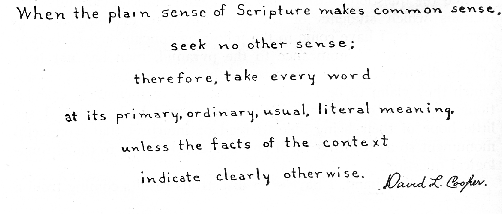|
Continued: Chapter XXI-Messianic Speculations How long are these 3½ years? The eleventh chapter of Revelation speaks of events which occur in the middle of Daniel's seventieth week--in the middle of the great tribulation. The prediction of verse 2 says that the Jewish Temple, which will be rebuilt in Jerusalem, will be trodden down by the nations for 42 months. This prediction refers to the latter half of the tribulation. Verse 3, however, speaks of 1260 days, during which the two witnesses give forth their testimony in Jerusalem. A study of this verse in the light of all the facts of the context shows that this period refers to the first half of the tribulation. In Revelation 13 we read of the ravings of the beast, who continues his mad career against God and man for 42 months--evidently the latter half of the tribulation. The woman of Revelation 12, who in verse 1 is called a symbol, flees into the wilderness, or into a place prepared for her, and there remains for a "time, and times, and half a time." This statement refers to the latter half of the great Tribulation. The first part of it is called 1260 days; the latter half is also spoken of as a period of 42 months, or "a time and times and half a time." From these facts it is concluded that a time is a year of twelve months, each of which has 30 days. The so-called prophetic year, therefore, is said to contain 360 days. The years mentioned in the Scriptures are the common ordinary years consisting of the four seasons, for "while the earth remaineth, seed time and harvest, cold and heat, and summer and winter, day and night shall not cease." The Hebrew years throughout the Scriptures are the common years consisting of the four seasons which are marked by the sowing, cultivation, and harvesting of the crops. As has been seen, the accepted chronology places the issuing of the decree for the rebuilding of the temple by Cyrus in 536 B.C. It is generally supposed that Jesus of Nazareth was executed in 32 or 33 A.D. From 536 B.C. to 32 A.D. there were 567 years--if no mistakes were made in the calculation. Let us think of the 483 years, from the issuing of the decree for the rebuilding of Jerusalem to the cutting off of the Messiah, as a surveyor's chain consisting of 483 links. At the same time, let us also conceive of the years of the period under consideration as a distance of 567 units, the length of each of which is equal to a link in the surveyor's chain. If our imaginary chain is staked down at the point represented by 536 B.C. and is carried forward at the other end, it will cover 483 units, but will lack 84 links of reaching the point representing 32 A.D. Since the chain is not elastic, it cannot be made to reach the point 32 A.D. Neither can the distance separating these two points be contracted until there are only 483 units. Seeing the discrepancy, many expositors draw up their stake at point 536 B.C., go forward to the other point 32 A.D., stake their chain down, and go backward along this line. They reach the point represented by the year 452 B.C. They cannot make the chain extend any farther; hence they stop short of 536 B.C. by 84 years. |
||

|
"It may be well to offer here two explanatory remarks. First: in reckoning years from B.C. to A.D., one year must always be omitted; for it is obvious ex. gr., that from B.C. 1 to A.D. 1 was not two years, but one year. B.C. 1 ought to be described as B.C. 0, and it is so reckoned by astronomers, who would describe the historical date B.C. 445, as 444 (see note p 124 ante). And secondly, the Julian year is 11m. 10.46s., or about the 129th part of a day, longer than the mean solar year. The Julian calendar, therefore, contains three leap years too many in four centuries, an error which had amounted to eleven days in A.D. 1752, when our English calendar was corrected by declaring the 3rd September to be the 14th September, and by introducing the Gregorian reform which reckons three secular years out of four as common years; ex. gr., 1700, 1800 and 1900 are common years and 2000 is a leap year. 'Old Christmas Day' is still marked in our calendars, and observed in some localities, on the 6th January; and to this day the calendar remains uncorrected in Russia." That the great pyramid at Gizeh was constructed by men who had a knowledge of astronomy and the principles involved in architectural engineering cannot be doubted. Its orientation and measurements together with many other elements reveal most clearly the fact that the builders of the pyramid were men who were very highly developed in the sciences of astronomy, mathematics and engineering. The history of exegesis through the centuries is indeed interesting and at the same time very pathetic. Too often expositors read into the text their own thoughts and present them to the unsuspecting people as the very Word of God. Unfortunately for the world, this practice has not been altogether abandoned, but we may be thankful that, as the years pass, there is, in many circles at least, a saner and a more scientific approach toward the Scriptures. For this improvement let us praise God. |
||

|
Every special, mystical, and symbolical interpretation should be discarded, and the plain sense of Scripture should be accepted unless there are clear indications in the context to indicate a departure from the normal, literal meaning. This general proposition is the logical deduction which we are forced to make from the survey of Messianic speculations made in this chapter. The End. |
||